After the German invasion of Belgium on 4 August 1914 hundreds of thousands of Belgians
fled to the Netherlands to seek refuge from the acts of war. Among these was a group of
40,000 Belgian military. Approximately 7,000 of these men escaped internment by disguising
themselves as civilians. The remaining group of military was, in conformity with the
international agreements made during the Second Peace Conference of The Hague in 1907,
disarmed and interned for the duration of the war. At first they were accommodated at
camps and barracks that were empty due to the mobilisation of Dutch military men who were
guarding the borders. One group of Belgians was accommodated in the barracks of Alkmaar
where at the same time a group of German military had already been
accommodated. This was
of course asking for trouble. A solution was offered by quickly erecting an internment
camp (or internment depot as it was called in those days) in Gaasterland
in the south west of Friesland (see map below).
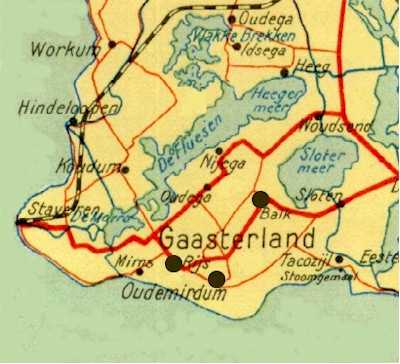 |
Map of the southwest
corner of the province of Friesland
on which is situated Camp Gaasterland |
On 26 May the Belgians that had been interned in Alkmaar were transferred to
Gaasterland.
They were accommodated in a hastily erected camp of tents. On 8 and 9 October another
group of Belgians was transferred to Gaasterland where they were housed in the brickworks
of Rijs and in the school and several sheds in the village of Sondel. In the villages
Nijemirdum, Oudemirdum and Bakhuizen accommodation was found in private
houses.
The
compensation per soldier was Hfl 0,60 for which 400 grams of meat had to be
provided. The
compensation for an overnight stay was Hfl 0,10 in case the government had to provide
food. On 23 and 24 October 1,600 Belgians arrived in Rijs; they were mostly from Camp
Loosduinen. They were transferred by train to Heerenveen to continue their journey to
Gaasterland from there. Six hundred of them went to the village of Warns.
On 27 October
the final group of 300 people arrived; they were accommodated at Balk. Together with the
Belgian men a lot of women and children arrived in search of their husbands and
fathers.
They were also given a home at Gaasterland. In the village of Bakhuizen 600 people were
accommodated, the largest part private houses. Two hundred of them were accommodated in
the old Catholic Church, from which the benches had been removed. The government rendered
cots and supplied food through an eating-house. The parish received Hfl 0,10 a night a
person.
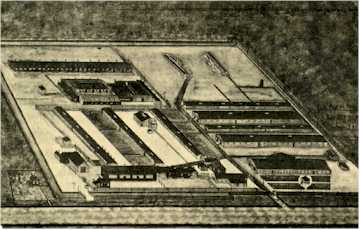 |
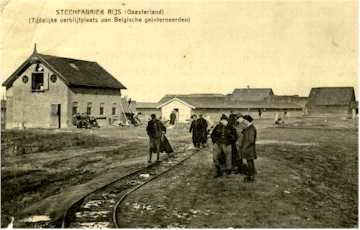 |
| View of the Rijs brickworks (Camp
Gaasterland) |
Internment camp Rijs (Camp
Gaasterland) |
The largest group of military was accommodated at Rijs. Some in private houses but the
larger part, 1,200 men, in the old Rijs brickworks. The ovens and peat sheds were cleared
to accommodate military refugees who had been reunited with their family.
The bachelors
lived in the former drying sheds that were boarded up and converted to
barracks. In 1915
two more barracks were built especially for families.
In July 1917 307 interned lived with
their family. A small school, an infirmary of 24 beds and a canteen were also built. Later
four barracks were added: two measuring 75 meters and two measuring 55 meters in
length.
In the village of Sondel there were another 600 soldiers put in private
houses. Next to
these there were refugees to be found in nearly every village in Gaasterland. Among others
in Harich and Balk and in Oudemirdum where 100 soldiers were housed in an old
shed.
A
separate barracks was built for the Belgian officers; every officer paid Hfl 10,- in rent
a month. An estimated maximum of 3,000 people have lived in Camp Gaasterland; according to
an official count on 1 January 1916 there were 15 officers and 2190 inferiors in Camp
Gaasterland.
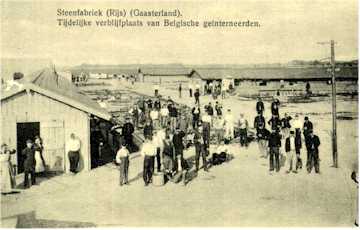 |
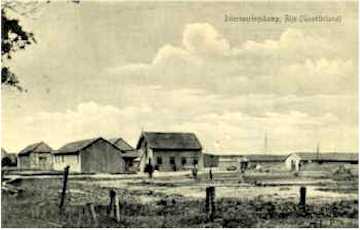 |
| View of the Rijs brickworks (Camp
Gaasterland) |
Internment Camp at Rijs (Camp
Gaasterland) |
The accommodation and hygiene were very bad to start with. Draughty barracks that
leaked like a sieve, wet straw on the floor, a lot of vermin and a shortage in clothing
and underwear (a lot of soldiers just had the clothes they were wearing). Overcrowding and
boredom led to alcoholism and rows. In course of time improvements were made.
To fight
boredom sports festivals were organised and several contests; in soccer, swimming and
Dutch tennis. On a cultural level there were music bands, a mandolin club and a drama
society. A lot of Belgians bided time by being active in the home industry (among other
things: manufacturing wood carving and jewellery) and objects were sold to the local
population. As a means of extra earnings acorns were collected. These were sold for 2 to 3
cents per kilogram to salesmen who sold the acorns to Germany.
Schooling programmes were also started. Schools for children were established in Rijs and
in the women’s village Boschkant. A working school for adults was established in Rijs
as well. Adults were educated and in addition they could take courses in
plumbing, forging
and furniture-making. After obtaining a diploma getting employment was
stimulated.
Finding
a job happened in consultation with the Dutch government as the Belgian interned were not
to supplant the Dutch workers on the labour market. However, there was a large shortage of
labourers because a large part of Dutch young workers was mobilised. This is why many
Belgian soldiers were able to find a job with the forest administration or as a farmhand.
They were also employed as a so-called internment group, supervised by the military. This
is why over 40% of all interned in the Netherlands was employed at the end of the war.
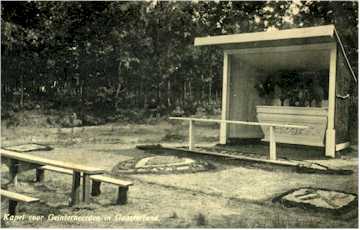 |
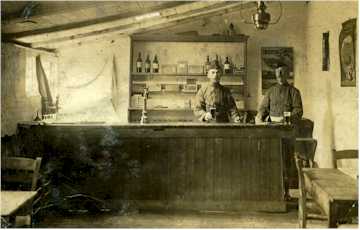 |
| Catholic Chapel for interned at Oudemirdum |
Canteen for interned in the brickworks at Rijs |
Women's Camp Boschkant
On the terrain near the road Rijs - Oudemirdum the women’s camp Boschkant was built.
It was put into use in late February 1916. The village was partly built under direct
management of the own interned skilled workers and partly put out to tender. The total
cost of building were Hfl 47.558,81. The village was made up of 5 barracks, each for 20
families, 4 private buildings, an electrical central bureau, a bath house with 6 showers
and a bath all with hot water, a sewing school, a site office, a shop, a house for the
head of the sewing school, a school with four classrooms and two three bedroom
apartments.
On the terrain were also some houses placed of the Quacker Society of Friends and a
building for the staff. The ill were nursed in the Belgian hospital which was made up of
two combined houses built in the Rijsterbosch (the forest of Rijs). Supervision and
administration were free of charge and in the hands of Major Höfer, the then commander of
Camp Gaasterland. Mrs.Höfer - born baroness 'van Heemstra' - had taken on managing the
sewing school.
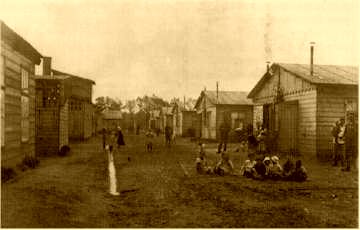 |
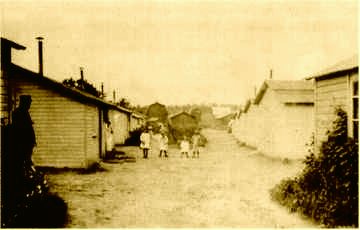 |
| Women's village Boschkant |
Women's village Boschkant |
Security of Camp
Gaasterland was in the hands of troops of the second and
third company of the first Battalion Landweer (a total of
450 men) under the command of colonel E. A. Tedema van
Berkhout, esquire. They were originally accommodated in
private houses, but were given their own quarters later. By
opening the bridges of Sloten, Woudsend, Galamadammen, Warns
and Lemmer (Tacozijl) a sort of island was created which
made escaping difficult. The bridges were under permanent
surveillance.
Camp Gaasterland was hard to guard due to its large size and
this is why a lot of Belgians were able to escape in the
beginning. The surveillance regime was tightened and in 1915
new rules were taken into use. From then on there was a
curfew and the soldiers were forbidden to rent any vehicles
(ice skates were considered vehicles as well). In spite of
this there were still many attempted escapes.
In September 1916 the
question was raised if closing down Camp Gaasterland would
not be economising. It turned out it would save money and it
was decided on 13 November that the camp was to be kept as a
reserve depot. Only one internment group remained. On 6 and
12 December 1916 906 interned left for Camp Harderwijk and
642 for Camp Amersfoort-Zeist. The guards were then reduced
to 261 men.
Literature:
Interneringsdepot Gaasterland - Belgische vluchtelingen
1914-1918
Authors: H. Doeleman, H. Dijkstra en J. Oosterhof
(Publicated by MAR EN KLIP - De Brink 4 - 8567 ZN Oudemirdum
- The Netherlands)
J. Kooiman - De Nederlandse strijdmacht en hare mobilisatie
1914
Verslag van de werkzaamheden der Centrale Commissie tot
behartiging der naar Nederland
uitgeweken vluchtelingen
|